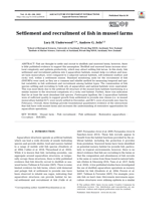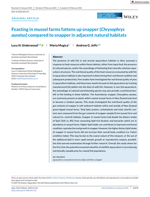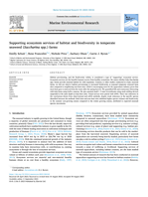In addition to supplying a nutrient-dense source of food, shellfish and seaweed aquaculture has the potential to provide important ecosystem services. Some of these services, like nutrient removal, are well-documented. Others, however, require additional research to better understand the extent of benefit as well as the ecological and management principles that influence their occurrence.
One such service is habitat provisioning; for fish and invertebrates, aquaculture gear and the organisms cultivated on/in them can serve as a shelter, while those same organisms – along with associated biofouling communities – can also serve as a food source. However, there is relatively scant data about these benefits, particularly when it comes to temperate seaweed aquaculture. A 2021 literature review found only seven studies that included quantitative information about commercial aquaculture’s value as habitat, all of which were focused on tropical seaweed systems.
Learn More About the Literature Review
Read a Summary HereA recently completed project sought to evaluate the habitat value of kelp aquaculture and kelp-mussel co-culture in the Gulf of Maine, USA, and the Hauraki Gulf, Aotearoa (New Zealand). Using comparative sampling methodology and equipment, researchers at the University of New England and the University of Auckland, with support from The Nature Conservancy, quantified the abundance and richness of species at aquaculture sites and non-aquaculture control sites.
Background Information About the Study
Read More HereIn the Hauraki Gulf, both mussel and kelp-mussel co-culture supported fish populations equivalent to or greater than that of the non-farm sites (in both richness and abundance), with wild fish found to be foraging and recruiting within the farms.
Furthermore, fish dwelling on the farm sites may be eating better diets than those living in natural habitat. Researchers investigated the gut contents of snapper within and outside of New Zealand green-lipped mussel farms, finding that the fish within the farms were in better nutritional condition due to their distinctly different diet of mussels and biofouling species (e.g. barnacles) made available by the farm. Together, these studies suggest that aquaculture can bolster fisheries and biodiversity by providing both a settlement and nursery habitat function for fish as well as a nutrient-dense food resource.
Read the Studies
-
 Settlement and recruitment of fish in mussel farms
Settlement and recruitment of fish in mussel farmsPublished in Aquaculture Environment Interactions on March 30, 2023.
DOWNLOAD -
 Feasting in mussel farms fattens up snapper
Feasting in mussel farms fattens up snapperPublished by Aquaculture, Fish and Fisheries in 2024.
DOWNLOAD -
 Diet of snapper in green-lipped mussel farms and adjacent habitats
Diet of snapper in green-lipped mussel farms and adjacent habitatsPublished in Aquaculture, Fish and Fisheries in 2023.
DOWNLOAD
Though the U.S. farm sites had similar farmed species and cultivation gear, the observed habitat value was noticeably different. In fact, there was no detectable effect on the abundance or diversity of invertebrates and fishes. But this lack of interaction between wild fauna and the farms is important; because seaweed farming in Maine is seasonal, and all gear and biomass is removed in the spring, these results provide evidence that the industry does not negatively impact wildlife. If those farms were providing significant habitat benefits during the winter, associated fauna could lose an important source of shelter and food when the growing season ended.
Read the Studies
-
 Supporting ecosystem services in temperate seaweed farms
Supporting ecosystem services in temperate seaweed farmsPublished in Marine Enivronmental Research on September 11, 2023.
DOWNLOAD -
 Consumer willingness to pay for farmed seaweed
Consumer willingness to pay for farmed seaweedPublished in the Journal of Applied Phycology on February 14, 2023.
DOWNLOAD
This research shows that, at the very least, kelp and shellfish farms can coexist with wildlife, causing no negative impact, and at best, they can provide valuable habitat with noticeable benefits to nature. However, the future of restorative aquaculture depends heavily on social acceptability, also known as the social license to operate.
To better understand the importance of aquaculture’s ecosystem services to consumers, researchers asked U.S. consumers what price they would be willing to pay for a range of seaweed products. They were then shown a 90-second video about the ecosystem services associated with seaweed farming and given the survey a second time. Regardless of the product or the respondent’s demographics, consumers indicated that they were willing to pay more for the same products after seeing the educational video. These findings justify continued research in this area and can guide efforts to actualize the large potential of kelp aquaculture.
Want to learn more?
More information about research methods, results, outcomes, and key learnings can be found in the project report, while a brief accompanying the research outlines recommendations for research, policy, and management.
